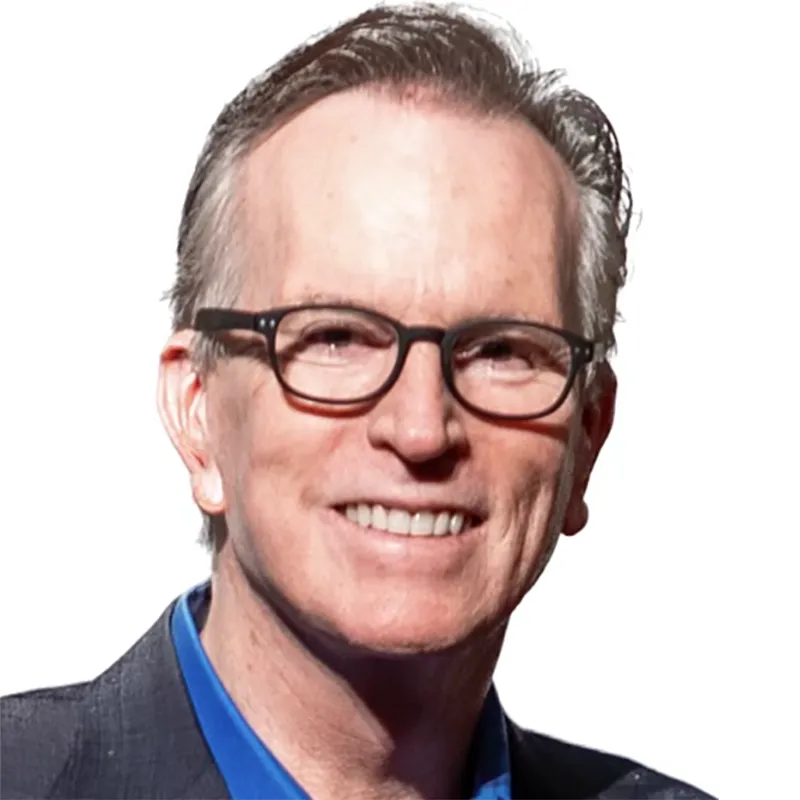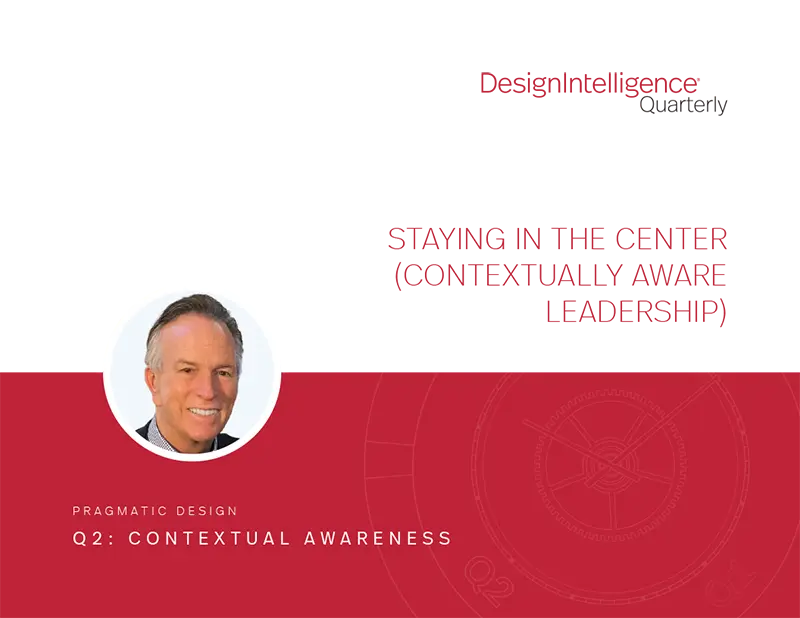Staying in the Center (Contextually Aware Leadership)
by Dave Gilmore
President and CEO, DesignIntelligence
June 14, 2023
Our recent Design Futures Council Leadership Summit on Technology & Applied Innovation in La Jolla focused on the theme of business transformation empowered through data and digital optimization. Central to the two-day event was the role of leadership to actualize the noted transformation. The prevailing message was this: From beginning to end, leadership’s role is to stay in it, learn along the way, ask curious questions and be a part of the team, not apart from it.
Central Posture
Leadership’s role is essentially a centrally postured position. Effective leaders manage their priorities and calendars to maintain this centrality. But when the calendar gets so packed that it’s managing the leader rather than the other way around, leadership is drawn out of the center and onto the peripheries of the seeming disconnectedness of secondary uselessness. Caught in this morass, leaders lose the point of leadership, and their organizations feel it.
I know this firsthand. My role at DesignIntelligence requires me to stay in, and lead from, the center of the organization. My job is to think, speak and live – to emanate – the transformation we’re focused upon, so it becomes functionally contagious. But like yours, my schedule is crazy sometimes. The phone calls and texts, the emails, meeting invitations and the legitimate push and pull from my partners and employees can all draw me away from the center where I’m most effective. Let me correct that statement: These things don’t draw me away, it’s me who loses focus and gets my priorities out of order. What defocuses you from your centered place as a leader?
Another illustration might help. I was visiting a leader several weeks ago whose firm is a member of the Design Futures Council. We had a great catch-up session and then got down to business. Over the years DesignIntelligence has supported this firm with direction, advice and leadership support. We’ve watched them transform from a strong, centralized organization to a globally decentralized design powerhouse. The choreography between those leading the business of design and those doing the work of design was carefully rehearsed over a long period to ensure extraordinary design outcomes and elevated bottom-line results. This is one of the most difficult challenges any design-centric organization must address.
As we began working through our agenda, I was struck by the scattered signals this leader expressed in language, body movements and shortened attention span as they introduced new themes and topics into the conversation. It was frenetic. Our dialogue began to feel unnatural to the point of awkwardness. I paused for an equally uncomfortable stretch to hopefully reset the tone – and he noted it. With a sheepish smile he admitted, “Ah! I’ve done it again! I’m all over the place, aren’t I? I’m so sorry, Dave. My partners have been harping on me that I’ve become so scattered I’m jeopardizing losing the primary agenda.”
I responded, “Well, it’s good to have partners who risk telling us what we don’t see, isn’t it?” I continued my query, “In this seeming scatteredness, what’s happening inside of you when you get to that place? What are you feeling or seeing that shifts you into that mode?”
He replied, “There’s far too much to do in any given day than any single leader or team of leaders can accomplish. I feel like we’re falling further behind and disappointing our key stakeholders ... the employees, consultants and partners who rely on us. All I can see is the growing list of to-dos, and so I kick in and try to knock as many of the items off the list as possible before more get added.”
Ever feel that way?

Foresight
Time is the most precious commodity ever invented by humans. There’s only so much of it allocated to our 24-hour constructs known as days. Once passed, a day is gone, never to return. Then a new one begins — one after another, until suddenly, sometimes known but often unanticipated, it all ends. The most effective leaders operate within the awareness of waning time and prioritize accordingly. Refuse to wade into the mire of deprioritized activities. Remember your role and prioritize around that. Delegate to your team the items central to their roles. Be the leader who remains focused and contextually aware.
Foresight is the forward-facing vision into the known, the probable and the possible, the consideration and expectation of wisdom that transcends the current time frame. Reliable foresight operates from a careful blend of historical understanding, a present awareness and an intelligent prognosis. An inadequate substation for foresight is agenda-based speculation. It’s marked by biased opinions, decontextualized single-fact inventories to “prove” points, derogatory commentary directed to repel opposing perspectives and pseudo-intelligent argumentation as the presentation layer intended to appear sophisticated.
As the new year advances, beware the speculators hawking wild claims about the future. Most will speak to the unseen future, wildly brought into vision through use of language and portents of ominous happenings. As built environment leaders, your job is to operate from the settled state of integrity that others depend on. Yours is the role best described as steady, founded and strategic.

Predictions
I like to play the game of throwing darts at a board marked by concentric rings leading to the bullseye in the center. It’s a matter of distance, arc, velocity, form and luck. Thankfully, I usually at least hit the board when throwing, but the surrounding wall is also densely populated with holes from the myriad darts that strayed far and wide from the target. In most dart-throwing establishments, you’ll note this phenomenon ... more miss the target than hit it. But I persist. And every once in a while, when I’m feeling it, I even hit the center. Joy and elation result!
But just because I hit the center every so often doesn’t make me a reliable, dependable or expert dart-thrower. If money was on the line, you wouldn’t want me on your team. I’m an amateur at this game and only do it for the fun of it. For the hope, the promise and the sport of “maybe” — “maybe” I’ll hit the center. Aware of the odds, I throw my darts with full awareness of the context — the time, space and conditions, and the potential risks and rewards.
Those who claim to be right in their predictions most of the time maintain a short, narrow foresight trajectory or claim they predicted something only after the fact. Even more frightfully, they have fooled themselves and those vulnerable enough to buy into their speculations.
What marks a speculator who believes their own distortions is the dynamic of extension. Such speculators will extend their cobbled-together cases further out on the time horizon, and those who bought their stories before will continue to buy into their projections. Beware the speculators, because they lead you away from integrity-founded intelligence that keeps you heads-up aware to the near- and intermediate-term futures you’re leading your organizations through.
As a leader of the built environment, your job is to operate from the calm, settled integrity others rely upon. Your role is best described as steady, founded and strategic. Stay the course of leadership from a centered and aware position — and enjoy dart throwing for what it is: a game.
What kind of leader are you?
Dave Gilmore is President and CEO of DesignIntelligence.


